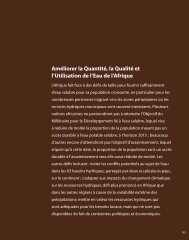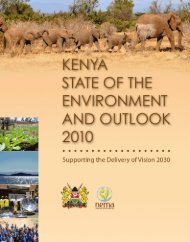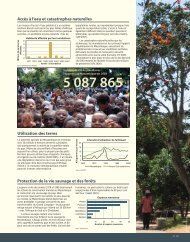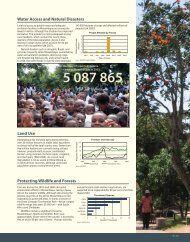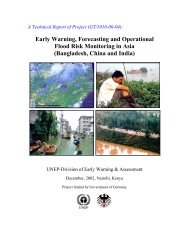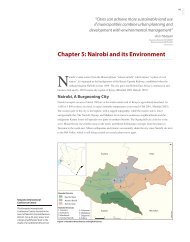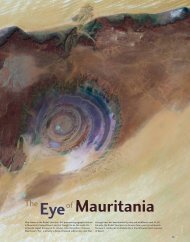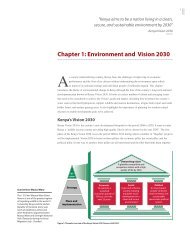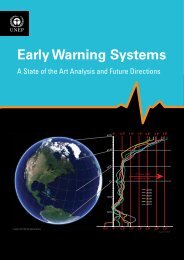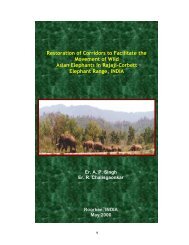Uganda Atlas of Our Changing Environment - GRID-Arendal
Uganda Atlas of Our Changing Environment - GRID-Arendal
Uganda Atlas of Our Changing Environment - GRID-Arendal
Create successful ePaper yourself
Turn your PDF publications into a flip-book with our unique Google optimized e-Paper software.
Rainy season: Kooki hills in the background overlooking Lake Kijanebarola, Rakai District (NEMA 2008)<br />
Origin <strong>of</strong> Lake Kijanebarola and River Rwizi-Kibare-Bukora system<br />
During the formation <strong>of</strong> the Western Rift valley system,<br />
landscape was tilted eastwards which led to rivers and<br />
streams being reversed to flow through new routes<br />
on a down warped landscape and drowned valleys.<br />
Consequently, a fairly long river system <strong>of</strong> Rwizi-Kibare-<br />
Bukora developed. The system originates from its<br />
uppermost catchment in the south-western highlands <strong>of</strong><br />
Itojo, Rwampara, and Buhweju in Ntungamo, Mbarara and<br />
Bushenyi districts, respectively. Due to the down warping<br />
effects, depressions were formed along its course, which<br />
were filled with water both from the river flow and from<br />
micro-catchments to form lakes Kacheera, Mburo and<br />
Kijanebarola. On its long course from the highlands to<br />
Lake Victoria, the river flows out <strong>of</strong> lakes, Kacheera and<br />
Mburo, through Kanagisa wetlands - a poorly defined<br />
valley system with numerous shallow depressions choked<br />
by wetlands; and then into Kijanebalola, a rather streak<br />
valley that was filled by water from the river and flanking<br />
cathments to form the lake. From Lake Kejanebarola, the<br />
system changes into Kibare-Bukora Rivers, which drain<br />
the Kooki hills through the Sango Bay plains, and then into<br />
Lake Victoria via the western shores.<br />
The Lake Kijanebalola feature is itself a recent formation,<br />
which is a result <strong>of</strong> drowning <strong>of</strong> part <strong>of</strong> Rwizi-Kibare river<br />
course. It is a very shallow lake with an average depth <strong>of</strong><br />
84<br />
5 m; and occupies a wide and streak valley, covering a<br />
surface area <strong>of</strong> 35 km 2 and with a circumference <strong>of</strong> about<br />
88 km. The name <strong>of</strong> the lake itself implies that it was<br />
formed when people were there seeing. Although the age<br />
<strong>of</strong> the lake is not readily known, it is a recent formation<br />
and could be traced and estimated through both scientific<br />
and folklore means.<br />
The water catchments <strong>of</strong> the rivers and lakes are<br />
experiencing heavy population pressures, which become<br />
the key driver <strong>of</strong> environmental change in the area. Due<br />
to population pressure, land degradation has increased<br />
to unprecedented magnitudes, especially through loss <strong>of</strong><br />
vegetation cover and soil erosion. This is thought to have<br />
reduced the hydrological potential <strong>of</strong> the catchments and<br />
consequently the volumes <strong>of</strong> water flowing through the<br />
river to the lakes. In addition, heavy silting <strong>of</strong> the river<br />
valleys and the lakes has the effect <strong>of</strong> reduced the water<br />
holding capacity <strong>of</strong> these water systems; and worse still,<br />
the shallow nature <strong>of</strong> the lakes and the high potential<br />
evaporation rates in the area may augment the problem.<br />
<strong>Environment</strong>al change<br />
Of recent both the river system and the lakes through<br />
which it drains have experienced heavy silting and<br />
this has affected the water quality to the extent that<br />
Rakai District Local Administration (2007)



